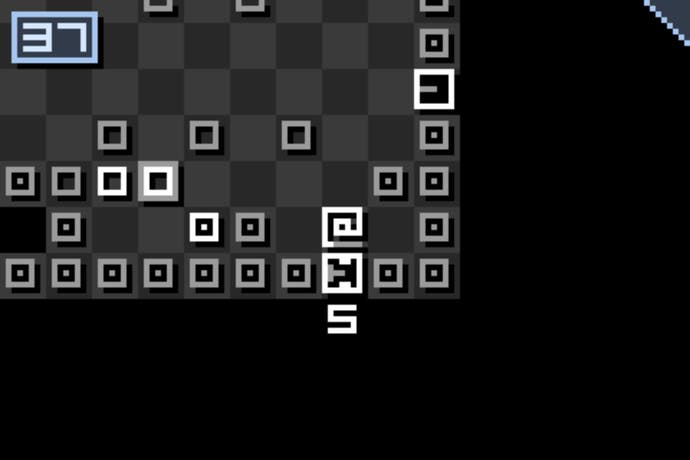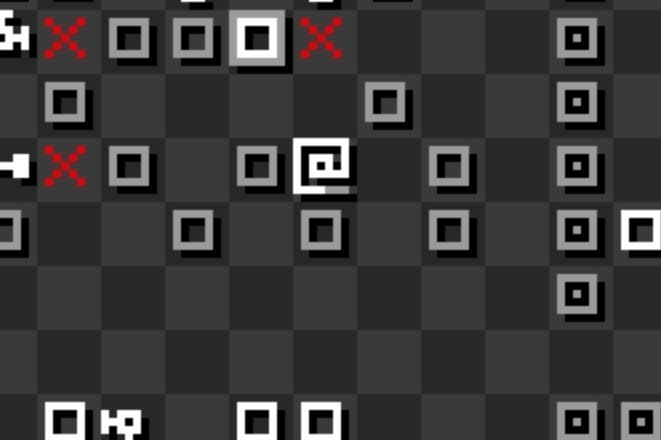Ending review
In my end is my beginning.
Ending is a nightmare, and the nightmare details a group of bone-white toilet plungers who want to kill you. Toilet plungers and a range of bleached euphoniums. And plumbers' L-bends. And a bunch of other things I can't even begin to name. Whatever: they're all after your blood.
Ending is also an elegantly pruned-back puzzler and a compact Roguelike. The puzzler's there to introduce the enemies, the combat, and the whole mindset of the project in a careful upwards arc of managed difficulty, and then the Roguelike comes along and it's like being at a zoo when somebody opens all of the cages at once. Suddenly, these pieces you're used to dealing with in relative isolation and at a polite cerebral distance are spilling out en masse. You're overrun. You're constantly on the back foot. You're dying the death of a million zugzwangs. It's wonderful.

So what's the big idea, Ending? The big idea is that you're an @ symbol, working your way through a chequerboard maze and fighting off a range of foes as you head for the exit. Whenever you take a move, your enemies do as well, and you can only kill them - by performing the @ symbol equivalent of a headbutt - when you're in a square that's directly adjacent to them. So with those plungers, for example, you have to sidestep and move in little circles until you've got them where you want them. Leave a space between you and your quarry when they're facing in the right direction, and they'll do you in on the next move.
That's Ending at its simplest. Pretty soon you're tackling little dumbbell guys who only shift up and down or left and right, or fixed turret types who are deadly if approached from certain directions, or push blocks, spawners, exploders, trailers, and a few other strains of horror. You're dealing with a range of elements and a handful of properties, spliced together in interesting ways. Whatever the challenge, space is important, but timing is equally crucial. It's about getting in sync with your next enemy, and then getting in sync with the enemy who comes after that. Oh, and on top of this you only have a set number of moves to work with before you keel over - although you can top these up a little with each kill.
If this sounds complex, don't worry: you'll click with it in seconds during the relative calm of those puzzle challenges - challenges that ensure you never have too much to tackle in any one go until you're working your way through the last half of them. Maybe you'll find it pretty simple even then, actually, in which case prepare yourself for that Roguelike mode, where the world of Ending is suddenly a sprawling panorama of cluttered terror.
The moment-to-moment rules are the same here, but that process of syncing with your foes - getting in step with their specific rhythms before you can finish them off - starts to feel like the weird ludic equivalent of turning the dial on an old radio, sorting through the noise in search of the tiniest splinter of a signal. The Roguelike offers huge rooms filled with complex congregations of foes, and beyond each door lies another room, and another, and another. Every exit becomes an entrance somewhere else - somewhere even worse.
A friend of mine recommended Ending because of its wonderful static-riddled shards of audio and the way they bring an appropriate ossified crunch to its brittle and surprisingly vivid combat. It's glorious stuff, but the sound direction's only a small fraction of the magic here. Designer Aaron Steed made his name with Red Rogue, an orgy of pixellated blood-letting that blended crafty design with a staggeringly fast pace of play. The blood's gone with Ending, but the swiftness and the brutality remains. This is pared-back game creation at its most sharp-edged: a sewing needle through the tear duct, a razor blade lodged in your brain.









